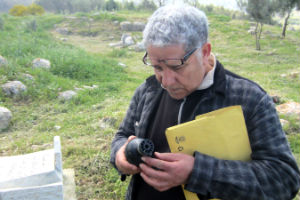
Ziad Assam walks on rubble inside the apartment complex where he used to live on August 13, 2014. It was heavily damaged in fighting between Israel and Hamas during four weeks of fighting in northern Gaza strip (Photo credit: Roberto Schmidt/AFP/Getty Images).
A prior version of this piece appeared in The Huffington Post.
At the time of writing, the latest ceasefire between Israel and Hamas is set to expire at 5 p.m. EST today. Against the backdrop of Gaza’s destruction, no one can fully predict what is next for Israeli and Palestinian combatants.
In its coverage of the conflict in Gaza and Israel, the New York Times has used a daily chart that risks misleading readers about the firepower involved. The chart in question improperly compares the total Israeli “targets” struck in Gaza to the number of “rockets” launched at Israel by Hamas and Palestinian armed groups.







